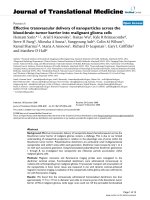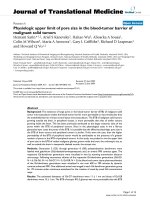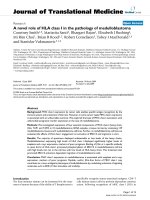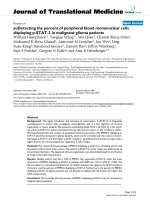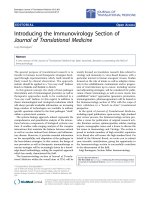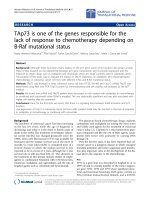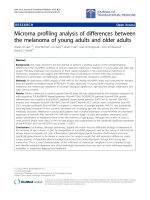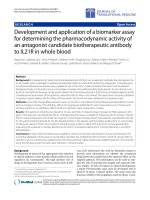báo cáo hóa học:" Measuring the impact of health problems among adults with limited mobility in Thailand: further validation of the Perceived Impact of Problem Profile" doc
Bạn đang xem bản rút gọn của tài liệu. Xem và tải ngay bản đầy đủ của tài liệu tại đây (240.08 KB, 8 trang )
BioMed Central
Page 1 of 8
(page number not for citation purposes)
Health and Quality of Life Outcomes
Open Access
Research
Measuring the impact of health problems among adults with limited
mobility in Thailand: further validation of the Perceived Impact of
Problem Profile
RoseAnne Misajon
1
, Julie F Pallant*
2
, Lenore Manderson
3
and
Siriporn Chirawatkul
4
Address:
1
School of Political and Social Inquiry, Monash University, 900 Dandenong Rd, Caulfield East, Victoria 3145, Australia,
2
School of Rural
Health, University of Melbourne, 49 Graham Street, Shepparton, 3630, Victoria, Australia,
3
School of Psychology, Psychiatry & Psychological
Medicine, Monash University, 900 Dandenong Rd, Caulfield East, Victoria 3145, Australia and
4
Faculty of Nursing, Khon Kaen University, Khon
Kaen, Thailand
Email: RoseAnne Misajon - ; Julie F Pallant* - ;
Lenore Manderson - ; Siriporn Chirawatkul -
* Corresponding author
Abstract
Background: The Perceived Impact of Problem Profile (PIPP) was developed to provide a tool for
measuring the impact of a health condition from the individual's perspective, using the ICF model
as a framework. One of the aims of the ICF is to enable the comparison of data across countries,
however, relatively little is known about the subjective experience of disability in middle and low-
income countries. The aim of this study was to assess the validity of the Perceived Impact of
Problem Profile (PIPP) for use among adults with a disability in Thailand using Rasch analysis.
Methods: A total of 210 adults with mobility impairment from the urban, rural and remote areas
of northeast Thailand completed the PIPP, which contains 23 items assessing both impact and
distress across five key domains (Self-care, Mobility, Participation, Relationships, and Psychological
Well-being). Rasch analysis, using RUMM2020, was conducted to assess the internal validity and
psychometric properties of the PIPP Impact subscales. Validation of the PIPP Impact scales was
conducted by comparing scores across the different response levels of the EQ5D items.
Results: Rasch analysis indicated that participants did not clearly differentiate between 'impact' and
'distress,' the two aspects assessed by the PIPP. Further analyses were therefore limited to the PIPP
Impact subscales. These showed adequate psychometric properties, demonstrating fit to the Rasch
model and good person separation reliability. Preliminary validity testing using the EQ5D items
provided support for the PIPP Impact subscales.
Conclusion: The results provide further support for the psychometric properties of the PIPP
Impact scales and indicate that it is a suitable tool for use among adults with a locomotor disability
in Thailand. Further research is needed to validate the PIPP across different cultural contexts and
health conditions and to assess the usefulness of separate Impact and Distress subscales.
Published: 21 January 2008
Health and Quality of Life Outcomes 2008, 6:6 doi:10.1186/1477-7525-6-6
Received: 9 August 2007
Accepted: 21 January 2008
This article is available from: />© 2008 Misajon et al; licensee BioMed Central Ltd.
This is an Open Access article distributed under the terms of the Creative Commons Attribution License ( />),
which permits unrestricted use, distribution, and reproduction in any medium, provided the original work is properly cited.
Health and Quality of Life Outcomes 2008, 6:6 />Page 2 of 8
(page number not for citation purposes)
Background
The International Classification of Functioning, Disability
and Health (ICF) was developed by the World Health
Organization (WHO) [1] to provide a standard, unified
language and framework to describe health and health-
related states. A specific aim of the ICF is to enable the
comparison of data across countries and health care disci-
plines. To achieve this, two areas need to be further
addressed.
The first is that until recently, much of the research world-
wide has focused on etiology, treatment and epidemiol-
ogy. An advancement of the ICF, compared with previous
classification tools, was to incorporate contextual factors,
including physical and social environmental factors as
well as personal factors (e.g. age, education, coping
styles), into a model of functioning and disability. Conse-
quently the ICF adopted a biopsychosocial approach,
integrating conventional medical and social models.
However, limited attention has been given to non-clini-
cal, particularly social and personal aspects of health, dis-
ability and illness [2].
In addition to the need to further elaborate on these con-
textual factors [1], there is a need for a clear statement
regarding where the ICF is placed in relation to the exten-
sive literature on subjective well-being and quality of life.
In its current form, the ICF provides an extensive frame-
work for the objective dimensions of human life, and
articulates in detail physical aspects of health and func-
tioning. Some have found it a useful framework to com-
pare the content of health-related quality of life measures
[3]. Greater clarity is required however as to how the ICF
might integrate both objective and subjective dimensions
to provide a more complete and comprehensive classifica-
tion of functioning, disability and health [4]. Indeed, the
current shift in health and disability research places
increasing emphasis on the social construction of disabil-
ity, and on the individual's subjective experience of his or
her health condition.
The second gap in the literature is that research on non-
communicable and chronic disease has been conducted
primarily in Western Europe and North America, and rel-
atively little is known about the subjective experiences of
disability in middle and low-income countries. Concern
has been raised about the application of Western notions
of well-being, illness and disability across different cul-
tures, including the adaptation of health and health-
related quality of life measures [5-8]. Cultural context
plays an important role in the experience of disablement,
and disability cannot be considered in isolation from fac-
tors such as ethnicity, gender, and religion. Little research
has been conducted to explore the interrelationship of
these factors. The RESILIENCE project addressed these
two gaps.
The RESILIENCE project (REsearch into Social Inclusion,
Locomotor Impairment and Empowerment through Net-
working, Collaboration and Education) was a large inter-
disciplinary, multi-country project which considered the
contextual factors which impact upon the subjective expe-
rience of physical impairments in Australia and Southeast
Asia. Both qualitative and quantitative research methods
were used to explore the personal and social environmen-
tal factors that contributed to disability and disablement
in the different country and social settings (see [9,10]).
One of the countries in which the project was conducted
was Thailand [11]).
Thailand has a national population of 63 million (31 mil-
lion male, 32 million female) [12], two thirds of whom
live in rural areas. As in many countries worldwide, the
elderly population is increasing (expected 7 million in
2010), due to higher life expectancy (69.1 years) (most
recent data available, Thailand [13]). A 1991 survey indi-
cated 1.1 million people with disabilities, equivalent to
1.8 percent of the then total population of 57 million. The
majority had physical disabilities, and resided in the poor
northeast region, followed by the north of Thailand [14].
A second survey conducted in 1999 produced similar
findings [15]. Studies have been undertaken in Thailand
examining health problems of people with disabilities,
particularly stroke, amputation or paraplegia [16-24];
however little work has been conducted on the experience
of living with disability (but see [25]).
As part of the RESILIENCE project, we developed the Per-
ceived Impact of Problem Profile (PIPP [9]) as a relatively
short, self-report instrument to assess, from the individ-
ual's point of view, the impact and distress associated with
a health condition, rather than the person's ability to per-
form a particular task [9]. It has been recommended that
the ICF be considered during the development phase of
instruments, as this assists in achieving a stronger basis for
international comparability [26]. For the development of
the PIPP, selection of the domains was guided in part by
the ICF, but also by a review of existing measures and a
series of qualitative interviews. One of the concerns of
existing measures is that most have been developed in
English-speaking countries, leaving researchers with the
options of either developing a new measure or translating
an existing measure [8], with consequent difficulties asso-
ciated with salience and comparability. The PIPP
addresses this concern in that the 23 items were devel-
oped on the basis of baseline ethnographic data, con-
ducted in collaboration with researchers from Australia,
Malaysia and Thailand. In all three countries, wording
and content were chosen carefully to ensure that the activ-
Health and Quality of Life Outcomes 2008, 6:6 />Page 3 of 8
(page number not for citation purposes)
ities described were suitable across different cultural con-
texts, for both men and women, and across different age
groups. The instrument was designed to be generic to
allow for comparisons across health conditions.
We have previously published our analysis of the PIPP,
validating its use among adults with mobility impairment
in Australia [9]. Overall, the five subscales (Self-care,
Mobility, Participation, Relationships, and Psychological
Well-being) showed adequate psychometric properties,
with both impact and distress subscales demonstrating
good fit to the Rasch model. In this paper, we use Rasch
analysis to assess the validity of the Perceived Impact of
Problem Profile (PIPP) for use among adults with a loco-
motor disability in Thailand.
Methods
The study was conducted in urban, rural and remote areas
of Khon Kaen Province in the Northeast Region (Isaan),
the setting of the Thai arm of the RESILIENCE study. The
Isaan region, with a population of 19 million, is the larg-
est of four regions in Thailand. The majority of the popu-
lation are of Lao descent and ethnicity, and those living in
rural areas are among the poorest in Thailand. Ethics
clearance was granted by Khon Kaen University and The
University of Melbourne.
Participant recruitment and data collection
A modified cluster sampling method was employed, fol-
lowing stratification into urban, sub-urban, rural and
remote areas. In total, 38 villages were randomly identi-
fied. In each village, the headman was asked to list names
of persons "having difficulty in movement" (in Isaan, pai
sai ma sai yak). A researcher then visited the persons iden-
tified, and during the visit, used a snowball technique to
identify other persons having difficulty in movement. All
persons who were invited to participate agreed to be
involved in the study. The participant criteria included age
(≥ 18 years), ability to communicate well enough to give
informed consent, and willingness to participate as well as
experience of a condition causing difficulty in movement.
These difficulties were ones defined by the participants,
reflecting lay understandings of impairment and ability,
and did not use pre-selected clinical criteria. The recruit-
ment area was extended to contiguous villages if a village
was not large enough to identify seven suitable partici-
pants. The study was conducted between September 2003
and August 2004.
The socio-demographic and health profile of participants
is listed in Table 1. In summary, 210 respondents in 40
villages, of whom 70 percent were female and 30 percent
male, participated in the quantitative survey. The average
age was 64 years old, with the majority living in rural areas
(73 percent) and having completed primary school level
Table 1: Socio-demographic and health profile of participants (N
= 210)
Variable %
Age
- Range [24–89 yrs]
- Mean yrs & SD [64.1 ± 14.7]
Gender
- Male 29.5
- Female 70.5
Residency
- Rural 72.9
- Urban 27.1
Marital status
- Never married 11.0
- De facto 3.3
- Married 51.9
- Separated/divorced./widowed 33.8
Child/ren in household
- Range [0–5 children]
- Mean & SD [1.2 ± 1.1]
- no children 30.0
- 1 child 31.0
- 2 or more children 39.1
Adults in household
- Range [1–9 adults]
- Mean & SD [3.5 ± 1.5]
- 1 adult only 8.1
- 2 adults 15.2
- 3 or more other adults 76.7
Religion
- Buddhist 99.0
- Christian 1.0
Ethnicity
- Thai 59.5
- Isaan 40.6
Education level
- Range [0–10 yrs]
- Mean yrs & SD [5.1 ± 4.2]
- Primary (1–6 yrs) 96.2
- Secondary (7–12 yrs) 3.8
- Tertiary (≥ 13 yrs) 0.0
Health Profile
Cause of mobility problems
- Sickness/Illness 34.3
- Accident 16.7
- Since birth 2.9
- Don't know 15.2
- Others 31.0
Other health problems
- Hypertension 10.5
- Diabetes 19.5
- Arthritis 3.8
- Stroke 1.0
- Heart disease 1.4
- Lung disease (inc.asthma, TB) 4.3
- Others 19.5
Duration of mobility problems
- Range [1–68 yrs]
- Mean years & SD [10.3 ± 11.3]
Health and Quality of Life Outcomes 2008, 6:6 />Page 4 of 8
(page number not for citation purposes)
education only (96 percent). Approximately half of the
participants were married, while a third were separated,
divorced or widowed. Two-thirds had one or more
child(ren) living in the house, and the majority had three
or more adults living in the one house (77 percent).
Almost all were Buddhist (99 percent), and of either Thai
or Isaan ethnicity (60 and 40 percent respectively). The
most common cause of mobility problems was sickness/
illness (34 percent), and the average duration of locomo-
tor impairment was 10 years.
Materials
Perceived impact and associated distress related to mobility
impairment
The Perceived Impact of Problem Profile (PIPP) was
developed as a relatively short, self-report instrument to
assess both the impact and the distress of health problems
from the individual's perspective [9]. The development of
the 23 items in the PIPP was guided in part by the WHO's
ICF [1]. The domains include self-care, mobility, relation-
ships, participation, and psychological well-being. For
each item, respondents were asked to rate on a 6-point
scale (a) 'how much impact has your current health prob-
lems had on [item of function or activity]'; and (b) 'How
much distress has been caused by the impact of your
health problem on [same item of function or activity]'.
The 6-point scale was anchored on either end by 'no
impact' and 'extreme impact' for the Impact scale and by
'no distress' and 'extreme distress' for the Distress scale.
High scores indicate greater impact. In the current Thai
study, the PIPP was interviewer administered, although
the instrument can be administered by an interviewer or
self completed. Instrumentation was developed in Eng-
lish. It was then translated into Thai, drawing on ethno-
graphic data collected during early phases of the study,
with the intent and precise meanings of terms discussed
and pre-tested during training. Clarity was confirmed
through back-translation prior to pilot testing and finaliz-
ing the instrument. The initial Thai language version of
the PIPP was pilot tested in the study area with a series of
interviews conducted with adults with mobility limita-
tions.
Other measures
Participants were also asked to complete information
regarding their socio-demographic background (age, gen-
der, years of formal education, ethnicity, religion, marital
status, and household size), health background (cause
and duration of mobility problems, co-morbidities), and
current health status as measured by the EQ-5D [27]. The
EQ-5D, developed by the EuroQoL group, is a standard-
ized, validated generic instrument and is available in Thai,
Malay, Bahasa Indonesia, and Chinese [28], and was
included in the study not only to provide a health status
profile of participants, but also for the purposes of validat-
ing the PIPP instrument. On the EQ-5D, respondents are
asked to describe their own health according to five
domains: self-care, mobility, usual activities, pain/dis-
comfort, and anxiety/depression.
The EQ-5D and PIPP were pretested with 20 people with
a disability in periurban communities of Khon Kaen City
to establish clarity of the questions and the sequence of
the items.
Statistical analysis
To assess the psychometric properties of each PIPP Impact
subscale, the relevant items for each were subjected to
Rasch analysis using the RUMM2020 software [29]. Rasch
analysis, which was originally developed by Georg Rasch
[30] is increasingly being used in the health and psycho-
logical sciences to guide the development and validation
of the measurement tools [31]. It provides a detailed anal-
ysis of many aspects of a scale, including the response for-
mat, fit of items and persons, item bias, internal
consistency, dimensionality and targeting.
The procedures adopted in this study are consistent with
those conducted in the preliminary validation of the PIPP
in an Australian sample (for details see [9]; for a more
detailed description of Rasch analysis procedures, see
[32]). The response format was evaluated by inspection of
the thresholds. Disordered thresholds would indicate that
respondents had difficulty consistently discriminating
among response options. Categories were collapsed if
required to achieve satisfactory model fit. The overall fit to
the model was assessed using the item-trait chi-square
interaction statistic, with a Bonferroni adjustment to the
probability value. Non-significant chi-square values indi-
cated model fit. Individual person-fit and item-fit were
also assessed using chi square statistics and fit residual val-
ues. Residual values between ± 2.5 were considered to
indicate adequate fit to the model. The Person Separation
Index (PSI) is equivalent to Cronbach alpha and provides
an estimate of the internal consistency reliability, with
values above .8 considered adequate. Item bias can occur
when different groups within the sample display different
response patterns to a particular item, despite being
equivalent in terms of the underlying characteristic being
measured. To identify any possible item bias across gen-
der and age, differential item functioning (DIF) was
assessed.
Preliminary analysis indicated high levels of concordance
in responses to the PIPP Impact items (associated with
function and experience) and PIPP Distress items (associ-
ated with feelings), despite linguistic differentiation. Peo-
ple tended to give the same value to each item for both
impact and distress. For the purposes of this paper, there-
fore, we chose to evaluate only one set of subscales, those
Health and Quality of Life Outcomes 2008, 6:6 />Page 5 of 8
(page number not for citation purposes)
relating to impact of health problems. Rasch calibrated
PIPP Impact subscales scores were exported to SPSS Ver-
sion 12 for further statistical analysis to assess the con-
struct validity of the subscales. Non-parametric
techniques were used due to the non-normal distribution
of scores for a number of the scales. Spearman correlation
coefficients were generated to assess the intercorrelations
among the PIPP Impact subscales. Mann-Whitney U tests
and Kruskal-Wallis Tests were used to compare PIPP sub-
scale scores across the various levels of responses to the
EQ5D items.
Results
Rasch analysis of PIPP Impact Subscales
Preliminary inspection of the threshold map (not shown)
for the PIPP Impact items indicated disordered thresholds
for many of the items. This suggests that respondents
experienced difficulty in utilizing the full 6-point response
scale, but instead typically used only four response points.
All items were therefore rescored by collapsing categories,
with a change in scoring from 012345 to 011223.
The four Self-care items showed adequate fit to the model
after Bonferroni adjustment to the alpha level (overall
item-trait interaction chi square = 19.65, df = 8, p = .01)
with good person separation reliability (PSI = .89). No
item showed misfit (see Table 2) and no DIF was detected
for either gender or age.
Good fit to the model was achieved for the five Mobility
items (overall item-trait interaction chi square = 17.0, df =
10, p = .07); however significant DIF for age was detected
for items carry and move around the house. Removal of the
item carry resulted in no DIF for any item, improved
model fit (overall item-trait interaction chi square =
11.33, df = 8, p = .18) and good person separation (PSI =
.85).
The four Relationship items showed good model fit (chi
square = 14.89, df = 8, p = .06) and adequate person sep-
aration reliability (PSI = .88). No items showed misfit
(Table 2) and there was no significant DIF for age and gen-
der.
A non-significant overall item-trait interaction chi square
was obtained for the five Participation items (chi square =
9.39, df = 10, p = .50), suggesting good model fit. No
items showed misfit (see Table 2), and there was no sig-
Table 2: Individual item fit statistics for PIPP Impact scale items
Location SE Fit Residual DF Chi Sq DF Prob
Self-care
4 Wash self 0.13 0.11 -1.21 105.45 7.96 2 0.02
5 Use toilet -1.24 0.12 0.27 106.18 1.07 2 0.59
6 Dress self -0.06 0.11 -0.12 106.18 6.99 2 0.03
7 Feed self 1.18 0.13 1.21 106.18 3.33 2 0.19
Mobility
9 Sit/stand 0.26 0.13 1.80 125.48 1.72 2 0.42
11 Use vehicle -0.21 0.13 1.26 98.39 0.38 2 0.83
12 Move – house 0.38 0.11 -1.64 125.48 3.85 2 0.15
13 Move – neighbourhood -0.43 0.12 -0.67 117.64 5.38 2 0.07
Relationship
14 People in authority -0.86 0.12 0.48 86.58 0.52 2 0.77
15 Neighbours & friends -0.21 0.11 -0.10 97.94 3.28 2 0.19
16 Relatives -0.10 0.11 -1.01 98.65 8.27 2 0.02
17 Close relationship 1.18 0.13 1.15 90.84 2.82 2 0.24
Participation
8 Assist family members 0.40 0.1 1.06 117.44 0.07 2 0.96
18 Family activities 0.15 0.10 0.32 121.9 5.31 2 0.07
19 Community activities -0.20 0.10 0.71 119.67 0.43 2 0.81
20 Activities you enjoy 0.32 0.10 1.09 110.01 2.19 2 0.33
21 Work -0.67 0.11 -0.39 86.97 1.38 2 0.50
Psychological
1 Overall life satisfaction -0.30 0.10 1.26 144.62 1.44 2 0.49
2 Moods & feelings -0.15 0.10 0.26 140.73 0.62 2 0.73
3 Confidence 0.05 0.10 1.36 131.4 0.03 2 0.98
22 Live independently 0.23 0.09 -0.95 145.4 6.13 2 0.05
23 Reliance on others 0.170 0.09 0.07 143.84 2.04 2 0.36
SE = Standard Error, DF = degrees of freedom, ChiSq = Chi square, Prob = probability All probability values non-significant after Bonferroni
adjustment for the number of items in each subscale.
Health and Quality of Life Outcomes 2008, 6:6 />Page 6 of 8
(page number not for citation purposes)
nificant DIF for age. However, significant DIF by gender
was found for participation in family activities, with males
showing a greater likelihood of endorsing this item than
females. Removal of the item resulted in fit to the model,
however the PSI value dropped from .79 to .72, indicating
a undesirable reduction in the person separation reliabil-
ity of the scale. Given that the DIF noted for the item was
relatively minor, and that the original overall model fit
was very good, it was decided to retain the item in the
scale for further investigation.
The five Psychological items revealed adequate person
separation reliability (PSI = .83) and good fit to the model
(overall item-trait interaction chi square = 10.27, df = 10,
p = .42). No items showed misfit (see Table 2) and there
was no DIF for gender or age.
Correlations among PIPP subscales
Table 3 shows the Spearman correlation coefficients (rho)
among the Rasch calibrated scores for the PIPP subscales.
The strongest correlation was between the impact on
Mobility and Self-care (rho = .69), with the lowest occur-
ring between Relationships and Psychological well-being
(rho = .39). The pattern of quite strong correlations
among the subscales is supportive of the construct validity
of the PIPP, given the expected relationship among the
various aspects assessed. None of the correlations were so
high as to indicate redundancy, with the highest of .69,
indicating only 48% shared variance.
Relationship with EQ-5D
The validity of the PIPP Impact subscales was assessed by
investigating the relationship with appropriate corre-
sponding EQ-5D items administered to participants. The
PIPP Self-care subscale was compared with the EQ-5D self
care item. Due to the small numbers of respondents in the
'unable' response category of the EQ-5D Self-care item,
respondents were collapsed into two categories: (1) no
problems (N = 129), and (2) some problems or unable to
care for self (N = 81). Mann-Whitney tests revealed signif-
icant differences between the two groups on the PIPP
Impact Self-care subscale (z = -8.28, p < .001). The mean
rank scores on the PIPP Impact Self-care subscale was
higher for the respondents classified as having self-care
problems on the EQ-5D (149 vs 78), supporting the valid-
ity of the PIPP Impact Self-care subscale.
Kruskal-Wallis tests were conducted to compare the PIPP
Impact Mobility subscale scores with responses on the
EQ-5D Mobility item (no problem, some problems, con-
fined to bed), although the majority of participants indi-
cated the middle category on the EQ-5D (i.e. 83%). There
was a statistically significant difference (chi-square =
22.53, df = 2, p < .001). Mean ranks for each group were
in the expected direction with those 'confined to bed'
showing the highest PIPP Impact Mobility scores (154 vs
105 vs 56).
Kruskal-Wallis tests were conducted to compare PIPP
Impact Participation scores for respondents in each of the
three response categories to the EQ-5D item 'Usual Activ-
ities' (no problems, some problems, unable to perform).
There was a statistically significant difference (chi-square
= 33.87, df = 2, p < .001), with mean ranks for each group
in the expected direction (i.e. those 'unable to perform'
showing the highest PIPP Participation impact scores: 138
vs 109 vs 68).
To assess the construct validity of the PIPP Impact Psycho-
logical Well-being subscale, scores were compared to
those obtained for the EQ-5D Anxiety/Depression item.
Kruskal-Wallis tests revealed a statistically significant dif-
ference in scores (chi-square = 22.62, df = 2, p = .001).
Mean ranks for each group were in the expected direction
with those indicating extreme anxiety and/or depression
on the EQ-5D also showing the highest PIPP Impact Psy-
chological Well-being mean rank scores (127 vs 107 vs
73).
Discussion
The aim of this study was to validate the use of the PIPP
among people with a disability in Thailand. The PIPP was
initially developed as a multidimensional generic meas-
ure of the impact and distress of health conditions from
the individual's perspective, and has been validated in an
Australian sample [9]. The initial validation of PIPP in
Australia revealed adequate psychometric properties for
five subscales (Self-care, Mobility, Participation, Relation-
ships, Psychological Well-being) for both impact and dis-
tress. One of the difficulties in translating Western-
developed concepts from English into different languages
is ensuring congruent meanings, particularly in the case of
abstract nouns. In Thai, the term 'distress' translates to
'took' or 'suffer', while impact is 'pon-kratop' or effect
[33,34]. These two words have a similar meaning in Thai,
although distress connotes cause; impact is consequence.
Initial analysis suggested that participants in the current
study did not necessarily differentiate between the terms
'impact' and 'distress.' Preliminary analysis indicated con-
Table 3: Spearman correlation coefficients among PIPP Impact
subscales
Impact subscales Self-care Mobility Relation Particip
Self-care
Mobility .693
Relationships .449 .422
Participation .561 .672 .524
Psychological well-being .629 .622 .386 .583
All correlations significant at p < .001.
Health and Quality of Life Outcomes 2008, 6:6 />Page 7 of 8
(page number not for citation purposes)
cordant scores for impact and distress on an item-by-item
basis, suggesting a lack of differentiation of the concepts.
An alternative explanation is the trend towards consist-
ency in responses, i.e. reporting would reflect the expecta-
tion that any illness that had specified impact would have
a similar level of distress. This latter interpretation is con-
sistent with the tendency for Thai to select the midpoint
on Likert scales, reflecting cultural values of harmony and
equanimity ("not good, not bad").
The similarity of Impact and Distress responses from Thai
participants contrasts with Australians, who were able to
distinguish the direct impact (function) of their health
condition and the distress (emotional response to loss of
function) caused by it. For this paper, we decided that it
would only be appropriate to attempt to validate the PIPP
Impact subscales at this stage for use in the Thai sample,
and not the Distress subscales. Further research is required
to explore the understanding of differences between
impact of health problems and the distress caused by this
impact, in the Thai context.
For all PIPP Impact subscales it was necessary to collapse
the original 6-point response scale to a 4-point response
scale. For most of the items disordered thresholds were
detected which suggested that, while participants could
consistently differentiate the two extreme response points,
they were not able to reliably distinguish among the four
response points in the centre of the scale. Although a
number of alternatives were considered, the most suitable
action was to recode all items from 012345 to 011223. It
may be appropriate in future administrations of the scale
for the four response points to be labeled (e.g. no impact,
mild impact, moderate impact, extreme impact) to assist
respondents to distinguish more clearly between response
options This change in scale format, however, would
require further psychometric testing.
The rescoring strategy used in this study was different to
the rescoring adopted in the previous Australian study,
which was collapsed to a simpler 3-point response scale
[9]. The reduction of the 6-point to the 3-point scale used
in the Australian validation resulted in adequate, but not
ideal, person separation reliability values (less than .80).
For this Thai sample a 4-point response scale appears to
be most appropriate, resolving disordered thresholds,
while retaining good person separation values (above
.80). It is recommended that at this stage of the develop-
ment of PIPP, no universal change to the response scale be
made. Rather, further research investigating the response
format across different health conditions and different
cultural contexts is required. Future studies involving the
pooling of data from multiple sites with the anchoring of
scores on a common metric, would allow further explora-
tion of the stability of the PIPP response format and item
content across different samples.
In the current Thai study the five PIPP Impact subscales
showed adequate psychometric properties, with all dem-
onstrating fit to the Rasch model. All subscales showed
adequate person separation reliability. Only one misfit-
ting item was identified (item 10 from Mobility: 'carry')
requiring removal from the subscale. No DIF was found
for either gender or age, except for participation in family
activities in the Participation subscale. Specifically, men
indicated a greater likelihood of endorsing this item than
women. Given that removal of the item would have
resulted in an undesirable reduction in the person separa-
tion reliability of the scale, and that the DIF was relatively
minor, the item was retained in the subscale. One possible
explanation for the DIF for this item is the interpretations
of the term 'family activity'. In traditional Thai settings,
earning an income and providing for the family is consid-
ered an important responsibility of men and therefore,
likely to be one of the major ways in which men evaluate
their 'participation in family activities' [35]. In the quali-
tative part of our study, many of the men indicated that
they were not able to work in the fields or participate in
wage labor because of their impairment, subsequently
impacting on their endorsement of the item.
The construct validity of the PIPP was assessed using the
Thai version of the EQ5D, which measures how much dif-
ficulty a person has in relation to various domains. Those
who indicated greater difficulty in regard to Self-care,
Mobility, and Participation as measured by EQ5D were
also more likely to report higher impact in the equivalent
PIPP subscale. Additionally, those who indicated higher
levels of anxiety/depression on the EQ5D also reported
higher levels of impact on the PIPP Psychological well-
being subscale.
Conclusion
The purpose in developing the PIPP was to construct a
suitable tool for measuring the impact and distress of a
health condition from the individual's perspective, using
the current ICF model as a framework. Consistent with the
biopsychosocial model underlying the ICF, the PIPP pro-
vides a tool that examines the physical, social, and psy-
chological impact of health. While both the Impact and
Distress scales have been validated for use in the Austral-
ian context, social, linguistic and cultural factors influence
the use of instrumentation in other settings. The results of
this study support the psychometric properties of the PIPP
Impact subscales in adults with locomotor disability in
Thailand. Further work is needed to assess the difference
between the Impact and Distress subscales of the PIPP and
to test the generalizability of these findings in larger stud-
ies, involving different health conditions and cultural set-
Health and Quality of Life Outcomes 2008, 6:6 />Page 8 of 8
(page number not for citation purposes)
tings. The optimal number of response points for the scale
also requires further investigation.
Abbreviations
DIF: Differential Item Functioning; ICF: The International
Classification of Functioning, Disability and Health;
PIPP: Perceived Impact of Problem Profile; PSI: Person
Separation Index; RESILIENCE: Research into Social
Inclusion, Locomotor Impairment and Empowerment
through Networking, Collaboration and Education; VAS:
Visual Analogue Scale; WHO: World Health Organiza-
tion.
Competing interests
The author(s) declare that they have no competing inter-
ests.
Authors' contributions
The literature review was undertaken by RM, the statistical
analyses were conducted by both RM and JP, the study
was designed by LM, SC, and JP, and the data collection
was managed by LM and SC. All authors contributed to
the preparation of the article and approved the final man-
uscript.
Acknowledgements
We thank Professor Peter Disler and Dr Elizabeth Bennett for their input
in the design of the project, Dr Sari Andajani-Sutjahjo and Ms Catherine Bai-
ley for their assistance with the data management, and Professor Alan Ten-
nant for assistance with the statistical analyses. We also acknowledge the
EuroQol Group for permission to use the EQ-5D. The research was
funded by the Australian Research Council through a Federation Fellowship
awarded to LM (FF0241243) and ARC Discovery Project Grant
DP0449614, The University of Melbourne.
References
1. WHO: International Classification of Functioning, Disability
and Health. Geneva: World Health Organization; 2001.
2. Global Forum for Health R: 10/90 Report on Health Research
2003–2004. 2004.
3. Cieza A, Stucki G: Content comparison of health-related qual-
ity of life (HRQOL) instruments based on the international
classification of functioning, disability and health (ICF). Qual
Life Res 2005, 14(5):1225-1237.
4. Ueda S, Okawa Y: The subjective dimension of functioning and
disability: what is it and what is it for? Disabil Rehabil 2003,
25(11–12):596-601.
5. Corless I, Nicholas P, Nokes K: Issues in cross-cultural quality-
of-life research. J Nurs Scholarsh 2001, 33(1):15-20.
6. Ingstad B: The myth of disability in developing nations. Lancet
1999, 354:757-758.
7. Miles M: Disability on a Different Model: glimpses on an Asian
heritage. Disab Soc 2000, 15(4):603-618.
8. Bowden A, Fox-Rushby J: A systematic and critical review of the
process of translation and adaptation of generic health-
related quality of life measures in Africa, Asia, Eastern
Europe, the Middle East, South America. Soc Sci Med 2003,
57:1289-1306.
9. Pallant J, Misajon R, Bennett E, Manderson L: Measuring the impact
and distress of health problems from the individual's per-
spective: development of the Perceived Impact of Problem
Profile (PIPP). Health Qual Life Outcomes 2006, 4(1):36.
10. Misajon R, Manderson L, Pallant J, Omar Z, Bennett E, Rahim R:
Impact, distress and HRQoL among Malaysian men and
women with a mobility impairment. Health Qual Life Outcomes
2006, 4(1):95.
11. Chirawatkul S, Manderson L, Rukwong P, Pongrou P, Sosome B,
Chomnirat W: Restricted mobility among villagers living with
physical disability in Northeast Thailand. . In review
12. Mahidol Population Gazette: Population and Development
Newsletter. 2004, 24(6):6.
13. Thailand Health Profile 1990–2000
[ />]
14. Country Report of Thailand: The Implementation of the
Agenda Action
[ />]
15. Country Profile on Disability: Kingdom of Thailand
[ />]
16. Kromvongkon S: Factors affecting health status among
amputee adolescents. Bangkok: Mahidol University; 2002.
17. Pimsaman P, Sagnounpoi J, Srinai P: Needs of Carers for caring of
stroke patients: a study in OPD Somdejchowpaya Hospital.
The Somdejchowpaya Hospital Journal 2001, 1(2):18-26.
18. Rewpaiboon W: Outcome of in-patient rehabilitation for
hemiplegia stroke at the Siridhorn National Medical Rehabil-
itation Center. Medical Rehabilitation Newsletter 2001, 10(2):14-27.
19. Somnouk J: Relationship of the stroke patients in doing daily
activities and care burden and social support of the carer at
home. Songkla: Prince of Songkla University; 1997.
20. Srinim N: Coping experience of the stroke patients living at
home. Songkla: Prince of Songkla University; 2002.
21. Sripatarapinyo J: Effect of teaching cares for careers for caring
of stroke patients. Bangkok: Mahidol University; 1997.
22. Suwanno J: The capability of care givers in caring of the stroke
patients before discharge. Bangkok: Mahidol University; 1997.
23. Hirunchunha S: Development of home care model for caring of
the stroke patients. Bangkok: Mahidol University; 1998.
24. Choungsawadsak S: Need of Careers for caring of the stroke
patient. Bangkok: Mahidol University; 1998.
25. King J: Muffled Voice: The experience of family living with spi-
nal cord disability in Northeast Thailand. Brisbane: The Univer-
sity of Queensland; 2004.
26. Swanson G, Carrothers L, Mulhorn K: Comparing disability sur-
vey questions in five countries: A study using ICF to guide
comparisons. Disabil Rehabil 2003, 25(11–12):665-675.
27. EuroQol_Group: EuroQol – a new facility for the measure-
ment of health-related quality of life. Health Policy 1990,
16:199-208.
28. EuroQol G: Website of the EuroQol Group. 2004.
29. Andrich D, Lyne A, Sheridan B, Luo G, eds: Rasch Unidimensional
Measurement Models (RUMM) 2020 (Version 4.0). Perth:
Rumm Laboratory Pty Ltd; 2003.
30. Rasch G: Probabilistic models for some intelligence and
attainment tests. Chicago: University of Chicago Press; 1960.
31. Tennant A, McKenna SP, Hagell P: Application of Rasch analysis
in the development and application of quality of life instru-
ments. Value Health
2004, 7(Suppl 1):S22-26.
32. Pallant JF, Tennant A: An introduction to the Rasch measure-
ment model: An example using the Hospital Anxiety and
Depression Scale (HADS). Br J Clin Psych 2007, 46:1-18.
33. Pinthong P: Isaan-Thai-English Dictionary. Bangkok: Thai
Watana Panich; 1989.
34. Sethabutra S: New Model English-Thai Dictionary. Ubonrach-
athanee: Siritham Press; 1980.
35. Rungreonkulkij S, Chaimee M, Jongudomkarn D, Watananukoonkiert
S, et al.: Family mental health. Journal of Nurses' Association of Thai-
land Northeastern Division 2004, 22(1):64.

